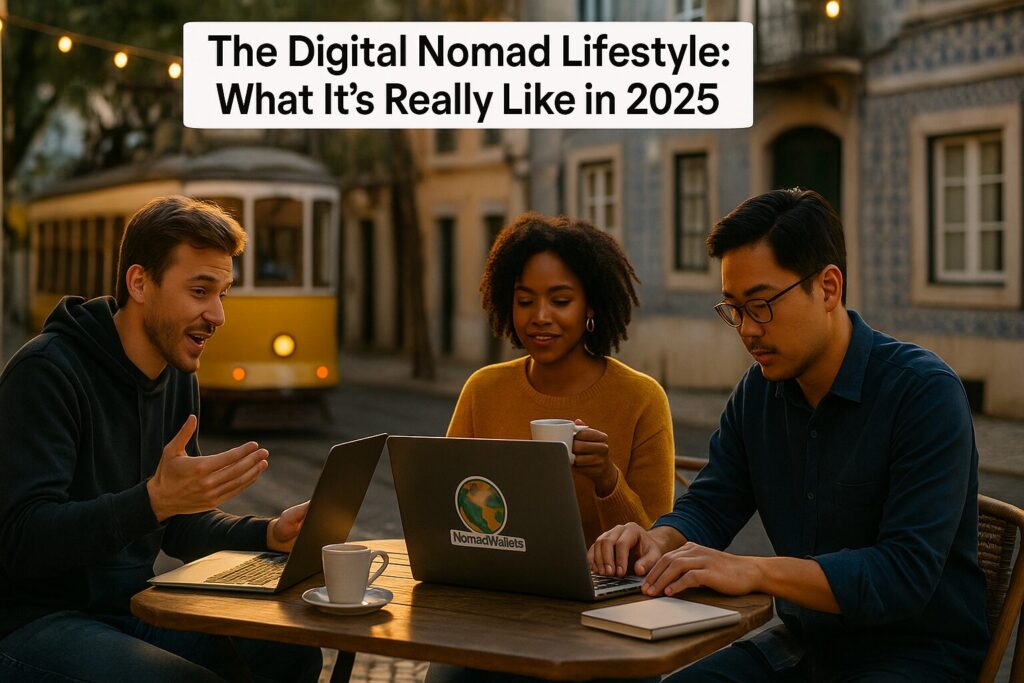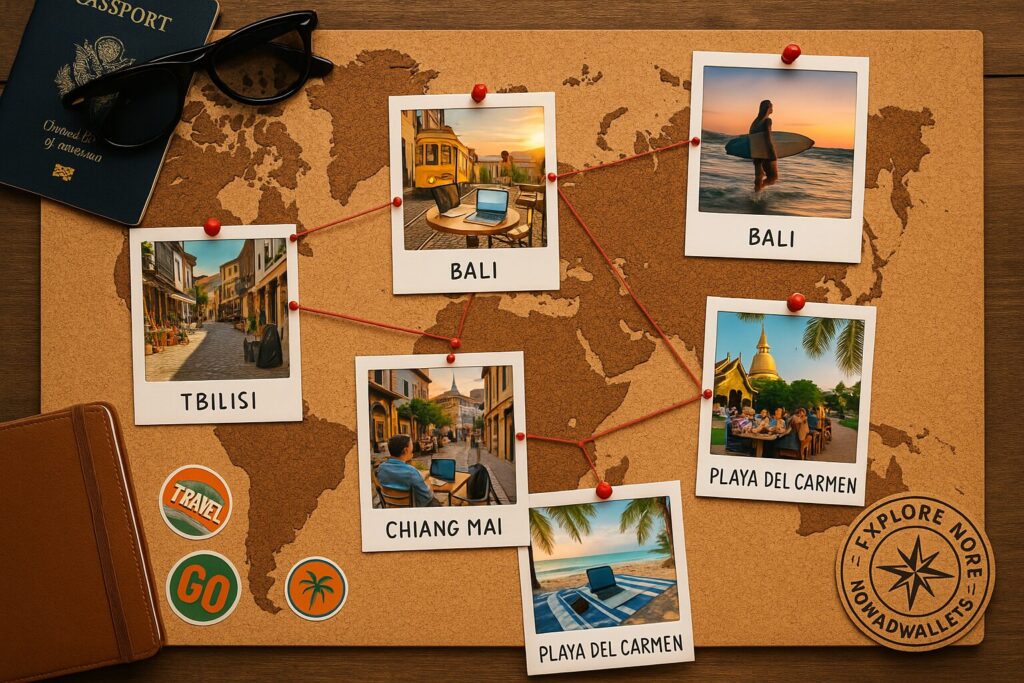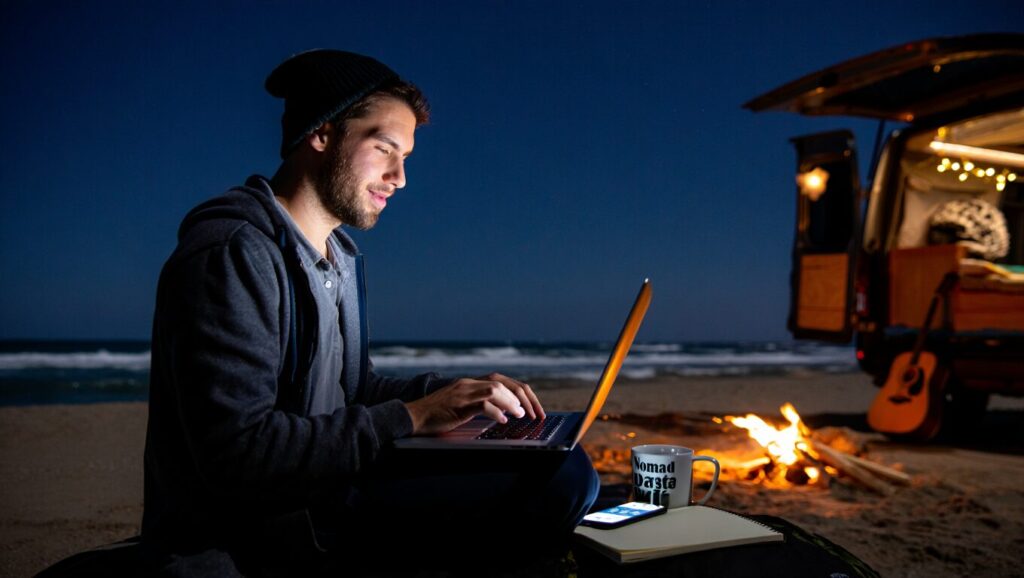
So, Uh… This Digital Nomad Life — What’s the Deal?
Alright, I’ll be honest.
I didn’t think I’d be that person — you know, the one living the digital nomad lifestyle, working from a café in another country. It always felt a bit… fake? Or like something only “tech guys” or travel bloggers did. Definitely not me.
But somehow… here I am. It’s 2025. And this lifestyle? Yeah. It’s kinda real now.
You’d be surprised how many people are doing it — not just the Instagram types. Regular folks. Teachers, designers, writers, VAs, even accountants (yes, seriously). The whole “remote job” thing isn’t special anymore. It’s just normal. Offices are optional. Commutes are history. And countries are literally giving out digital nomad visas like candy.
Sounds cool, right?
And it is. Sort of.
I mean, yeah — I’ve worked from rooftops. I’ve taken meetings in hammocks (bad idea, btw, your laptop WILL fall). I’ve lived out of a backpack. Some days feel like a dream.
But there are also those days when you’re eating gas station noodles in Croatia, your Wi-Fi dies during a client call, and you suddenly miss your mom for no reason. It’s not always fun. It’s not always pretty. And it sure as hell isn’t always easy.
But I wouldn’t trade it.
Well — most of the time.
So if you’re here wondering: “Is this for me?” or “What’s it actually like, though?” — let me help.
In this messy little guide, I’ll tell you:
- What the digital nomad life really looks like (no filters)
- What a random day might actually feel like
- The stuff that rocks
- The stuff that sucks
- And some places that make it easier (or at least more fun)
No hype. No sugarcoating. Just the truth — the good, the weird, and the Wi-Fi outages.
Cool? Cool. Let’s go.

What Is the Digital Nomad Lifestyle?
Let’s break it down.
A digital nomad is someone who earns a living online while traveling or living in different places—either short-term or long-term. It doesn’t matter if you’re freelancing, running your own online biz, or working full-time for a remote-friendly company. If you can do your job from a laptop and choose where you do it? That’s the nomad life.
But here’s the part people miss:
It’s not just vacationing with a laptop.
You’re still working. You’ll have deadlines, Zoom calls, invoices, and days when you don’t want to look at your screen anymore. The difference? You’re doing it from a beach town in Mexico, a mountain café in Georgia, or a rooftop coworking space in Lisbon.
There’s more than one way to “nomad.”
Not everyone does it the same way—and that’s the beauty of it. Here are a few common types of digital nomads in 2025:
- 🧳 Full-time nomads – They’re always on the move. New country every few weeks or months. Their home is wherever the Wi-Fi connects.
- 🐢 Slowmads – They stay in one place for a while (think: 1–3 months minimum) to really settle in and get some rhythm.
- 💼 Remote employees – They’ve got full-time jobs but aren’t chained to a city. Some live abroad permanently, others hop around.
- 🏖 Seasonal nomads – They work abroad part of the year, then return home when it makes sense. Think summers in Europe, winters somewhere warm.
Whether you’re a backpack-carrying minimalist or someone who rents long-term Airbnbs with a proper desk setup, there’s no “right” way to live the digital nomad lifestyle.

A Day in the Life of a Digital Nomad (2025)
So what does a typical day look like for someone living the digital nomad lifestyle in 2025? The truth is, no two days are ever exactly the same — and that’s part of the magic. But here’s a glimpse into what many nomads experience while balancing work, travel, and life on their terms.
Morning: Wake, Work Zones & Wellness
Mornings often start differently depending on your time zone and client base. Some nomads wake up early to sync with U.S. hours, while others enjoy slow mornings in a quiet café overlooking the sea.
- Check Slack, emails, and project updates (often while sipping a local coffee)
- Quick home or hotel workout — or a yoga class nearby
- If in a new place, maybe a walk through the local market or a beach jog
Time zone juggling is real — tools like World Time Buddy help keep meetings in check.
Midday: Deep Work + Coworking Culture
Most nomads block a few solid hours for focused work during midday, often using a local coworking space or a favorite café with strong Wi-Fi and good vibes.
- Work sprints using Pomodoro or Notion task lists
- Connect with teammates or clients on Zoom
- Grab lunch nearby — street food in Bangkok or fresh tapas in Barcelona
📍 Pro Tip: Coworking hubs are where many digital friendships and collaborations begin.
Afternoon: Freedom & Exploration
After work wraps up (or gets paused), it’s time to explore. Whether it’s wandering through old cities, hiking, diving, or joining a cooking class, afternoons are about soaking in the culture.
- Visit a local museum, beach, or nature spot
- Meet up with fellow nomads from a Facebook or WhatsApp group
- Attend a local event, language exchange, or remote work meetup
The best part? You’re never just a tourist — you live there, even if just for a while.
Evening: Recharge or Create
Evenings vary. Some nomads chill with Netflix and street food in their Airbnb. Others join group dinners, hit a live music spot, or work on their side hustle or content creation (YouTube, writing, freelancing, etc.).
- Online meetings with teams in different time zones
- Journaling, editing travel videos, or writing blog content
- Dinner with new friends from the coworking space
💬 Some of the best conversations happen with strangers who become travel family.

Pros of the Digital Nomad Lifestyle
The digital nomad lifestyle comes with some serious perks — and for many, it’s the freedom and variety that make it so addictive. Here are some of the biggest advantages nomads enjoy in 2025:
Freedom to Choose Where You Live
You’re no longer tied to one city or country. Want mountains this month and beaches the next? You can design your life around the places that inspire you most.
Exposure to New Cultures and Experiences
From tasting local street food to learning new languages, every destination becomes a classroom. Traveling while working gives you deeper insight into the world — not just as a tourist, but as a temporary local.
Minimalist Lifestyle = Less Stress
When you live out of a backpack or suitcase, you learn to let go of clutter — both physical and mental. The simplicity of nomad life often brings surprising peace of mind.
Networking with Global Professionals
Coworking spaces, coliving hubs, and online communities let you connect with entrepreneurs, creatives, and remote workers from every corner of the world. It’s professional networking — without the business suits.
Lower Cost of Living in Some Regions
Destinations like Thailand, Georgia, and Colombia offer a high quality of life for a fraction of what you’d spend in major Western cities. That means your money goes further, and your savings can grow.
Challenges Digital Nomads Face
As exciting as this lifestyle is, it’s not without its difficulties. Digital nomads deal with unique challenges that can impact productivity, health, and well-being — especially if you’re going solo.
Loneliness and Homesickness
It’s easy to feel disconnected when you’re far from family and friends — especially during holidays or rough days. While many nomads build strong new connections, it can take time and effort.
Time Zone Struggles
Working with a global team? Meetings at odd hours can mess with your sleep, productivity, and social life. Smart scheduling tools help, but time zones remain a real hurdle for many.
Visa and Legal Limitations
Not every country is “nomad friendly.” Tourist visa limits, complicated digital nomad visas, and unclear remote work laws can create uncertainty or force you to move more often than you’d like.
Maintaining Routines & Fitness
When you’re constantly moving, it can be tough to stick to a workout routine, sleep schedule, or healthy eating habits. Having discipline and creating small routines is key.

Internet Issues in Remote Areas
While many cities offer blazing-fast Wi-Fi, it’s not guaranteed everywhere. Some beach towns, islands, or rural escapes may have patchy connections — which can disrupt client calls and deadlines.
Tips to Actually Thrive as a Digital Nomad
Let’s be honest: the digital nomad lifestyle looks dreamy on Instagram — but living it well takes a bit of effort. It’s not just about working from beaches and sipping coconut water. If you want to thrive, not just survive, here are some tips that come from experience (and a few lessons learned the hard way):
Find a Routine That Works for You
Freedom is amazing — but without some kind of structure, things fall apart fast. Try setting regular work hours (even if flexible), plan your days loosely, and build in time for rest. Even just having a “morning routine” can keep you grounded.
Don’t Do It All Alone — Join a Community
Traveling solo is powerful, but community keeps you sane. Join coworking spaces, coliving houses, or even local WhatsApp groups for nomads. It’s a great way to meet people, make friends, and not feel like a stranger everywhere you go.
Slow Down — Seriously
One of the biggest rookie mistakes? Trying to “see it all.” Traveling too fast leads to burnout. Instead, stay in each place for a few weeks (or even months). It gives you time to settle in, work properly, and really enjoy the culture — not just check it off your list.

Use Smart Tools That Make Life Easier
A few apps can seriously improve your day-to-day:
- Trello or Notion – to keep your work (and brain) organized
- Airalo – for data wherever you land
- Nomad List – for checking cost of living, safety, internet, and more
- Wise or Revolut – to avoid crazy international bank fees
Don’t Skip Insurance
It’s easy to think “I’ll be fine,” until you’re not. Travel insurance is a must. Whether it’s for a sprained ankle or a stolen laptop, it’s better to be safe than stuck.
👉 Check out our nomad insurance guide here

Favorite Digital Nomad Hubs (in 2025)
Some cities just get it. Fast Wi-Fi, great food, welcoming people, and a built-in community of remote workers. If you’re looking for your next base, here are a few tried-and-tested spots that nomads keep coming back to:
📍 Lisbon, Portugal
Charming, colorful, and full of life. Lisbon has great weather, tasty food, and some of the best coworking cafés in Europe. Plus, the surf is just a short train ride away.
📍 Bali, Indonesia
Still a classic — especially spots like Canggu or Ubud. It’s affordable, inspiring, and full of people doing creative work in between yoga classes and beach sunsets.
📍 Medellín, Colombia
Don’t let the past fool you — Medellín today is one of the most innovative and welcoming cities in Latin America. The climate? Spring, all year round.
📍 Tbilisi, Georgia
A cozy capital with a big heart. Tbilisi is budget-friendly, super safe, and surprisingly full of nomads who love good food, chill vibes, and the freedom of Georgia’s remote worker visa.
📍 Chiang Mai, Thailand
Ask any long-term nomad where they started — there’s a good chance it was Chiang Mai. It’s calm, affordable, and has a coworking space on almost every corner.
📍 Playa del Carmen, Mexico
Beaches, tacos, and high-speed internet? Yes please. Playa is a perfect mix of vacation mode and work mode — and it’s easy to meet others doing the same.
👉 Want even more ideas? Check out our full list:
📖 25 Best Solo Travel Destinations for Digital Nomads in 2025
The Present and Future of the Digital Nomad Lifestyle
The digital nomad lifestyle has been gaining much attention in recent years. Let’s talk about how this lifestyle is changing and what direction it will take in the future, especially looking toward 2025. Digital nomads are people who use technology to work without being restricted by location. Now, in addition to simply enjoying traveling, an environment is being created where work and leisure can be enjoyed at the same time.
More places are saying ‘Come and stay’
Many cities and regions around the world are welcoming digital nomads. For example, Dubrovnik, Croatia, known for its beautiful coastline and historic architecture, is emerging as an attractive location for digital nomads.
Technology is making it easier
Technological advancements are making the digital nomad lifestyle easier. With the emergence of cloud services and various collaboration tools, an environment is being created where you can work efficiently anytime, anywhere.
It’s not just about traveling alone
The digital nomad lifestyle is no longer just about traveling alone. Many people are traveling with friends or family and sharing their work experiences together.
Transforming into Mindful Travel
Mindful travel has been gaining attention recently. Rather than simply combining work and travel, it is becoming important to look back on one’s inner self and find true relaxation.

Conclusion: Creating a life that works for me
Ultimately, the digital nomad lifestyle is a process of creating a life that suits me. Through experiences in various places and communication with people, we can create a better life. I believe that the digital nomad lifestyle in the future will become more diverse and move in a direction that can inspire many people. Find your own digital nomad lifestyle!
You don’t have to sell everything and leave tomorrow. Maybe your version of this lifestyle is working remotely for a few months a year, or just testing it out from a nearby city. And that’s totally valid.
Frequently Asked Questions: Digital Nomad Lifestyle (2025)
Q1. What exactly is the digital nomad lifestyle?
The digital nomad lifestyle means working remotely while traveling the world. Instead of being tied to an office, digital nomads use laptops and Wi-Fi to earn from anywhere—beaches, cities, mountains, or cafés. It’s about freedom, flexibility, and creating a lifestyle that blends work and exploration.
Q2. Do digital nomads work full-time or part-time?
Both! Some nomads work full-time jobs remotely (as employees or freelancers), while others take on part-time gigs or run online businesses. Many design their schedule around their travel pace, prioritizing flexibility over 9-to-5 routines.
Q3. Is the digital nomad lifestyle expensive?
It depends on where you go and how you live. Cities like Lisbon or Playa del Carmen can be very affordable, with monthly budgets between $1,000–$2,000. Living in Southeast Asia or South America can reduce costs even further. That said, flights, visas, insurance, and coworking spaces are important to budget for.
Q4. How do digital nomads make money?
Popular income sources include:
* Remote jobs (tech, marketing, customer support, etc.)
* Freelancing (writing, design, development)
* Online businesses (dropshipping, coaching, blogging)
* Content creation (YouTube, courses, affiliates)
👉 Check our remote jobs guide to explore options.
Q5. How do nomads stay productive while traveling?
Productivity comes from building a routine, choosing the right environments (coworking spaces or quiet cafés), and using helpful tools like Notion, Trello, or Pomodoro timers. Slow travel also helps—staying longer in one place reduces burnout and improves focus.
Q6. What about visas—how do digital nomads stay legal?
Many countries now offer digital nomad visas that allow remote work while living abroad. Popular options in 2025 include Portugal, Georgia, Estonia, Mexico, and Costa Rica. Always check local regulations to avoid overstaying tourist visas.
Q7. Is the digital nomad lifestyle lonely?
It can be at times, especially when constantly moving. However, most nomads overcome this by joining coworking spaces, coliving houses, Facebook groups, or local meetups. Many solo travelers build strong friendships on the road.
Q8. Do I need travel insurance as a digital nomad?
Yes—100%. Travel insurance or digital nomad insurance helps cover medical emergencies, theft, trip delays, and more. Popular providers in 2025 include SafetyWing, Genki, and World Nomads.
Q9. Can families or couples be digital nomads too?
Absolutely. The nomad lifestyle isn’t just for solo travelers. Many couples, families, and even retirees have adopted remote work lifestyles—with homeschooling, community living, and slow travel making it work beautifully.
Q10. What’s one tip you’d give someone starting the digital nomad lifestyle?
Start slow and plan realistically. Try working remotely in your home country first to test your routine, then travel to beginner-friendly cities like Lisbon, Bali, or Medellín. Build habits and systems that support long-term balance, not burnout.
👉 Thinking about trying it?
Our full beginner-friendly guide is now live — no hype, just real steps.
Read now: How to Become a Digital Nomad in 2025 🔗
✉️ And hey, if you want honest tips, new destination ideas, or tools that actually help —
[Join the newsletter]. I share useful stuff every week, no spam, no fluff.
Hi, I’m Tushar a digital nomad and the founder of NomadWallets.com. After years of working remotely and traveling across Asia and Europe, I started NomadWallets to help U.S. nomads confidently manage money, travel, banking, crypto, and taxes. My mission is to make complex financial topics simple, so you can focus on exploring the world and building true location freedom.
